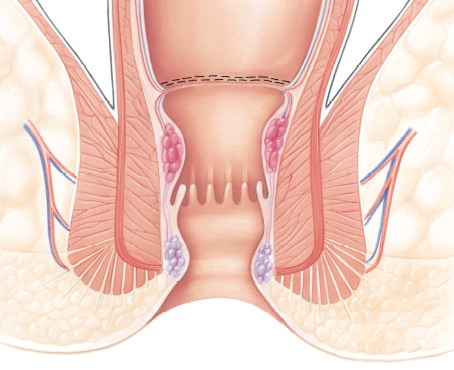What is Stapled Hemorrhoidopexy?
Also known as the Procedure for Prolapse and Hemorrhoids (PPH), stapled hemorrhoidopexy is a technique that uses a circular stapler to reposition and remove excess tissue in the rectum, which is causing the prolapse. At the same time, the procedure also lifts the prolapsed tissue back into the anal canal.
The procedure is typically completed within an hour. First, the surgeon will insert a proctoscope, a specialised instrument fitted with a light, to view the insides of the rectum and anus. The stapling device is inserted through the proctoscope and positioned around the prolapsed hemorrhoid tissue. Once the device is in place, the surgeon will fire it, creating a circular staple line that removes the excess tissue and lifts the prolapsed tissue back into place.
The stapled hemorrhoidopexy technique most effectively treats grade III and IV hemorrhoids. However, it may also be used to treat grade II hemorrhoids in some instances.
Benefits of Stapled Hemorrhoidopexy
Stapled hemorrhoidopexy offers several benefits for patients compared to traditional hemorrhoidectomy procedures. Some of these benefits include:
- Reduced pain and discomfort: Since the procedure removes less tissue than traditional hemorrhoidectomy surgeries, patients generally experience less postoperative pain and discomfort.
- Faster recovery times and shorter hospital stays: Patients typically require less recovery time and can return to work and normal activities sooner than with traditional hemorrhoidectomy procedures. Hospital stays are also shorter, typically ranging from 24-48 hours.
- Lower risk of bleeding and other complications: The stapling device creates a circular staple line that seals the tissue, reducing the risk of bleeding and other complications that can occur with traditional hemorrhoidectomy procedures.
- Improved cosmetic outcomes: As the procedure removes less tissue, there is less scarring and better cosmetic outcomes than traditional hemorrhoidectomy surgeries.
- Prevents of Stenosis of anal canal
Recovery and Aftercare for Stapled Hemorrhoidopexy
After the stapled hemorrhoidopexy procedure, patients will be monitored in a recovery room before being discharged home. Patients may experience discomfort and pain after the procedure, which can typically be managed with pain medications prescribed by the surgeon. Patients should also expect bleeding and discharge for a few days after the procedure.
Patients must follow specific instructions for wound care and activity restrictions during recovery. These instructions may include avoiding strenuous activity, drinking more water, and following a soft, fibrous diet to avoid constipation. Patients should also avoid lifting heavy objects and straining during bowel movements to prevent damage to the surgical site.
Patients typically have a follow-up appointment with their surgeon within a few weeks after the procedure to monitor the healing process and address any concerns or complications.
Conclusion
Stapled hemorrhoidopexy is a safe and effective procedure for treating prolapsed hemorrhoids. Patients should undergo a thorough preoperative evaluation and follow specific instructions for preparation and aftercare to ensure the best possible outcomes. While there are risks associated with any surgical procedure, the stapled hemorrhoidopexy technique is a valuable treatment option for patients suffering from severely prolapsed hemorrhoids. If you are experiencing symptoms of hemorrhoids, it is essential to speak with your doctor to determine the best treatment for your specific needs.
FAQs
Q: What is the difference between stapled hemorrhoidopexy and traditional hemorrhoidectomy surgery?
A: Stapled hemorrhoidopexy is a less invasive technique that uses a special circular stapler to reposition and remove excess tissue in the rectum. Traditional hemorrhoidectomy involves the complete removal of hemorrhoids using surgical instruments.
Q: What is the typical recovery time for stapled hemorrhoidopexy?
A: Recovery times can vary depending on the individual patient and the extent of the procedure. However, many patients can return to normal activities within a week or two after the surgery.
Q: What are the benefits of stapled hemorrhoidopexy?
A: The benefits of this surgery include reduced pain and discomfort, faster recovery times, shorter hospital stays, lower risk of bleeding, and improved cosmetic outcomes.





Comments are closed.